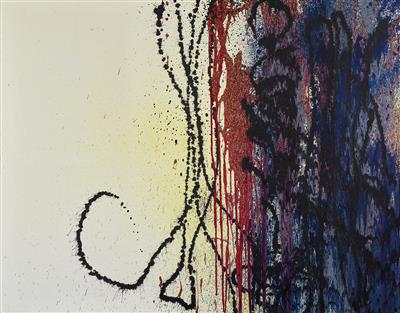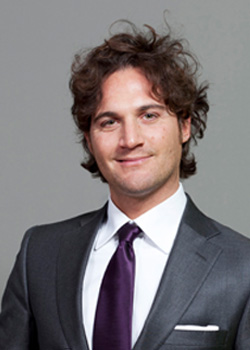Hans Hartung *

(Leipzig 1904–1989 Antibes)
T1988-E40, 1988, signed and dated on the reverse, inscribed fait le 24.9.88/ Phc 25.9.88/ Ph AA 136 du 1.10.88 on the reverse, acrylic on canvas, 142 x 180 cm, framed
This work is registered at Fondation Hans Hartung et Anna-Eva Bergman, Antibes and will be included in the Catalogue raisonné de l’Oeuvre de Hans Hartung currently being prepared.
Provenance:
Galerie Sapone, Nice (certificate available)
European Private Collection
Exhibited:
Nice, Galerie Sapone, Hartung Peintures 1988, February - April 1989, exh. cat.
After a stroke in 1986 confined him into a wheelchair, Hartung’s ability to paint was very limited; a huge blow for an artist whose career up to that point had been based on decisive, almost violent gestures. What could have heralded the end of an artistic career was soon translated into an opportunity; an entry into a new stylistic phase characterised by great creative freedom.
No longer concerned with suppressing the accidental figurative allusions contained in his work, Hartung produced spontaneous canvases inspired by nature. His later works, which include T1988-E40 and 1989-H5 reveal great ambition and a complex interrelation of expressions and emotions.
In the catalogue Hans Hartung, Paris: Chapelle de la Sorbonne Daniel Abadie notes how the use of the ‘sulfateuse’ allowed Hartung to best express the individuality of the single canvas, constructed along to a fantasy of intertwined lines and dense patches of colour, which became a metaphor for a vision of nature developed by the artist in this period. The ‘sulfateuse’ is a sort of spray hose normally used in gardening but was repurposed by Hartung to compensate for the lack of manual control caused by the stroke. This freer use of colour, made up of overlapping layers that mix freely, creates patterns in the canvases of this period whose vivacity and substance recall the strength and energy of primordial matter, in a formal language that ignores traditional composition, testing the stylistic conventions that had distinguished his works up to that moment.
Working on the large format, which lends itself best to the control of the sulfateuse, Hartung created works in which the colour, spread through off-centre sprays on the canvas, at times airy, at times chromatically thicker, expresses his vision of the relationship between painting, matter, and energy, in a palette ranging from pale blue to deep blue, from lemon yellow to black and red.
In an interview with Libération the artist declared: ‘The age, the view of the world, now aggressive, now sweet, positive or negative depending on the moment, and this wish to live, to be part of life, are the things I try to express in my paintings’.
Certainly the later works would not have existed if it had not been for the accidental discovery of the sulfateuse but there is certainly something more to them than random circumstance: paradoxically, his approaching death would seem to have given Hartung the freedom to go beyond what was familiar to him, while the reduction of his physical strength and mental faculties appears to have resulted in new attention to the sensitivity of painting. He was able to continue to seek pleasure in painting and to maintain the connection between expression and energy that he had always placed at the centre of his experimentation.
Expert: Alessandro Rizzi
 Alessandro Rizzi
Alessandro Rizzi
+39-02-303 52 41
alessandro.rizzi@dorotheum.it
24.06.2020 - 16:00
- Dosažená cena: **
-
EUR 186.300,-
- Odhadní cena:
-
EUR 90.000,- do EUR 120.000,-
Hans Hartung *
(Leipzig 1904–1989 Antibes)
T1988-E40, 1988, signed and dated on the reverse, inscribed fait le 24.9.88/ Phc 25.9.88/ Ph AA 136 du 1.10.88 on the reverse, acrylic on canvas, 142 x 180 cm, framed
This work is registered at Fondation Hans Hartung et Anna-Eva Bergman, Antibes and will be included in the Catalogue raisonné de l’Oeuvre de Hans Hartung currently being prepared.
Provenance:
Galerie Sapone, Nice (certificate available)
European Private Collection
Exhibited:
Nice, Galerie Sapone, Hartung Peintures 1988, February - April 1989, exh. cat.
After a stroke in 1986 confined him into a wheelchair, Hartung’s ability to paint was very limited; a huge blow for an artist whose career up to that point had been based on decisive, almost violent gestures. What could have heralded the end of an artistic career was soon translated into an opportunity; an entry into a new stylistic phase characterised by great creative freedom.
No longer concerned with suppressing the accidental figurative allusions contained in his work, Hartung produced spontaneous canvases inspired by nature. His later works, which include T1988-E40 and 1989-H5 reveal great ambition and a complex interrelation of expressions and emotions.
In the catalogue Hans Hartung, Paris: Chapelle de la Sorbonne Daniel Abadie notes how the use of the ‘sulfateuse’ allowed Hartung to best express the individuality of the single canvas, constructed along to a fantasy of intertwined lines and dense patches of colour, which became a metaphor for a vision of nature developed by the artist in this period. The ‘sulfateuse’ is a sort of spray hose normally used in gardening but was repurposed by Hartung to compensate for the lack of manual control caused by the stroke. This freer use of colour, made up of overlapping layers that mix freely, creates patterns in the canvases of this period whose vivacity and substance recall the strength and energy of primordial matter, in a formal language that ignores traditional composition, testing the stylistic conventions that had distinguished his works up to that moment.
Working on the large format, which lends itself best to the control of the sulfateuse, Hartung created works in which the colour, spread through off-centre sprays on the canvas, at times airy, at times chromatically thicker, expresses his vision of the relationship between painting, matter, and energy, in a palette ranging from pale blue to deep blue, from lemon yellow to black and red.
In an interview with Libération the artist declared: ‘The age, the view of the world, now aggressive, now sweet, positive or negative depending on the moment, and this wish to live, to be part of life, are the things I try to express in my paintings’.
Certainly the later works would not have existed if it had not been for the accidental discovery of the sulfateuse but there is certainly something more to them than random circumstance: paradoxically, his approaching death would seem to have given Hartung the freedom to go beyond what was familiar to him, while the reduction of his physical strength and mental faculties appears to have resulted in new attention to the sensitivity of painting. He was able to continue to seek pleasure in painting and to maintain the connection between expression and energy that he had always placed at the centre of his experimentation.
Expert: Alessandro Rizzi
 Alessandro Rizzi
Alessandro Rizzi
+39-02-303 52 41
alessandro.rizzi@dorotheum.it
|
Horká linka kupujících
Po-Pá: 10.00 - 17.00
kundendienst@dorotheum.at +43 1 515 60 200 |
| Aukce: | Současné umění I |
| Typ aukce: | Salónní aukce |
| Datum: | 24.06.2020 - 16:00 |
| Místo konání aukce: | Wien | Palais Dorotheum |
| Prohlídka: | 18.06. - 24.06.2020 |
** Kupní cena vč. poplatku kupujícího a DPH
Není již možné podávat příkazy ke koupi přes internet. Aukce se právě připravuje resp. byla již uskutečněna.
Všechny objekty umělce
